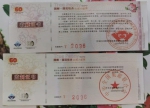国邮 · 国花牡丹丝娟大邮票
《国邮·国花牡丹》大邮票一套三卷,票面分别为:1、本届邮展小型张;2、国家邮政局1964年发行的牡丹小型张;3、15枚牡丹套票。 《国邮·国花牡丹》大邮票打破了中国邮政邮品开发的窠臼,首次在形式、规格、装帧方面作出了大胆地突破,使《国邮·国花牡丹》大邮票成为第一套画轴式大邮票,成为世界上最大的邮票,更是世界上首次采用书画专用丝绢和专用宣纸印制的邮票,是我国第一套国花牡丹专题邮品。《国邮·国花牡丹》大邮票分为丝绢版和宣纸版两种,分别采用高级传统书画专用丝绢和专用宣纸;为便于保存和长久收藏,邮票采用防水油墨,对宣纸版还进行了最新的防水技术处理,可以保存数千年。
A three-volume set of "National Post and National Flower Peony" stamps, the face of the stamps are: 1. The current stamp sheetlet; 2. The peony sheetlet issued by the State Post Bureau in 1964; 3. 15 peony sets. The "National Post·National Flower Peony" stamp broke the quarrel in the development of China Post's philatelic products. For the first time, it made a bold breakthrough in form, specification and binding, making the "National Post·National Flower Peony" the first set of large scroll stamps. , Became the largest stamp in the world, and it was also the first stamp printed in the world using special silk and rice paper for calligraphy and painting. It was my country’s first set of national flower peony special stamps. The "National Post·National Flower Peony" stamps are divided into two types: silk and rice paper. They use high-grade traditional calligraphy and calligraphy special silk and special rice paper respectively. For the convenience of preservation and long-term collection, the stamps are made of waterproof ink. The latest waterproof technology can be stored for thousands of years.
牡丹,又名百花王、花王、富贵花和洛阳花,原产于中国。牡丹花朵华贵、繁盛,花色富丽、娇艳,聚天地之灵气,日月之秀色,万卉之美韵名甲天下,象征着富贵、王权和社会的繁荣昌盛,自唐宋以来,牡丹被人们习惯称为国色、国香、国艳、国貌,并被历代定为国花。1915年出版的《辞源》“国花”条目中,即有“我国向以牡丹为国花的”诠释。牡丹引种到世界各国后,受到了世界人民的广泛喜爱,被昵称为中国花和洛阳花。牡丹文化是中华民族文化的一个重要组成部分,从《诗经》开始,历朝历代的文人墨客留下了大量的歌咏牡丹的诗词歌赋。牡丹文化兼容多门科学,构成非常广泛,包括哲学、宗教、文学、艺术、教育、风俗、民情等所有文化领域。牡丹文化是精神文明和物质文明相结合的产物,从古今中外牡丹发展的历史来看的确如此。国运昌时花运昌,牡丹发展在盛世,太平盛世喜牡丹。
Peony, also known as Hundred Flower King, Flower King, Fortune Flower and Luoyang Flower, is native to China. The peony flower is luxurious and prosperous, its color is rich and delicate, it gathers the spirit of the heaven and the earth, the beauty of the sun and the moon, and the beauty of Wanhui is famous all over the world. It symbolizes wealth, royal power and the prosperity of society. Since the Tang and Song Dynasties, the peony has been accustomed to it. It is national color, national fragrance, national beauty, national appearance, and has been designated as the national flower by the ages. In the "National Flower" entry of "The Source of Cis" published in 1915, there is an interpretation of "Our country uses peony as its national flower". After being introduced to countries around the world, peony has been widely loved by people all over the world, and is nicknamed the Chinese flower and Luoyang flower. The peony culture is an important part of the Chinese culture. Starting from the "Book of Songs", literati and literati in all dynasties have left a large number of poems and verses singing peony. The peony culture is compatible with many sciences and has a very broad composition, including all cultural fields such as philosophy, religion, literature, art, education, customs, and folk customs. Peony culture is the product of the combination of spiritual civilization and material civilization, which is true from the history of peony development at home and abroad. When the national fortune is prosperous, the flowers are prosperous, the peony develops in the prosperous age, and the peaceful prosperous age is happy for peony.
牡丹是百花丛中最鲜艳夺目的花,《牡丹》邮票就是新中国邮票中端丽妩媚,雍容华贵和当之无愧的“花王”,其“高贵”的地位无与伦比。从历史文化到人们喜爱和珍藏《牡丹》邮票,借机抒发自己对《牡丹》邮票和祖国历史文化的情怀。现如今《牡丹》邮票在中国邮票乃至世界邮票的海洋中大放异彩、具有很高的收藏价值。
The peony is the most colorful flower among the hundreds of flowers. The "Peony" stamp is the charming, graceful, and well-deserved "Flower King" in the middle of the New China stamps. Its "noble" status is unparalleled. From history and culture to people's love and collection of "Peony" stamps, I took the opportunity to express my feelings about "Peony" stamps and the history and culture of the motherland. Nowadays, "Peony" stamps shine in the sea of Chinese stamps and even the world's stamps, and have a high collection value.








